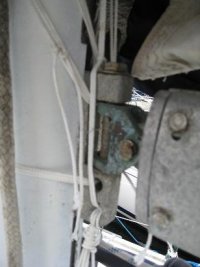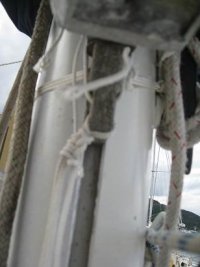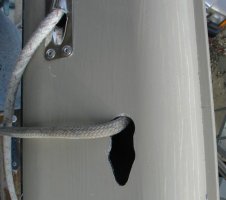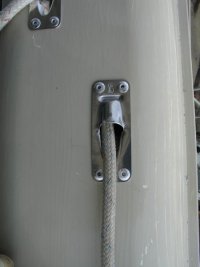A couple of options
If there is a spare sheave at the masthead, you can rig what is essentially a spare main halyard (really something you should have for extebnded cruising anyway) and use this for a topping lift/spare halyard/method of going aloft.
Also, there should be a couple of holes for a clevis pin near the aft end of the masthead crane. The traditional (and original I would guess) set-up is that you have a line or wire with a spliced eye at the end through which the clevis pin is attached, meaning the topping lift (in this case it is ONLY a boom topping lift) is fixed at the masthead and in the simplest form (assuming it was measured correctly) will have a shackle at the end which can attach to the boom end, but the better way is to have a 3 or 4:1 purchase at the end of this line, which would be attached to the boom-this way you have some adjustment of boom height.
When sailing (after the main is hoisted), you can either slack off the purchase and leave the topping lift attached (and just adjust it as needed to support the boom while you are reefing, remembering to ease it back off once the reef is correctly set up), or you can detach it from the end of the boom and secure it at the mast near the gooseneck so that it is not flopping around behind the leech of the mainsail while sailing. If you decide to reef you can just bring it back to the end of the boom and attach it during the reefing procedure (and of course just before you lower the mainsail when done sailing). In all case, it is ESSENTIAL that the toppong lift have ZERO LOAD once the mainsail is hoisted, reefed, or unreefed. Otherwise you will be pulling against the topping lift as you trim in the mainsheet rather than tensioning the leech of the mainsail. This is something we see all the time-folks forget to ease off the topping lift, and wonder why they can't get leech tension when they trim in the mainsheet (bad form!).
If I were planning on extended cruising though, I would rig it like a halyard so it is adjustable in the same way a halyard is via the masthead and deck sheaves if they exist, and I would size the line so that is strong enough to actually be a spare halyard.
Hope this makies some sense!
Cheers




